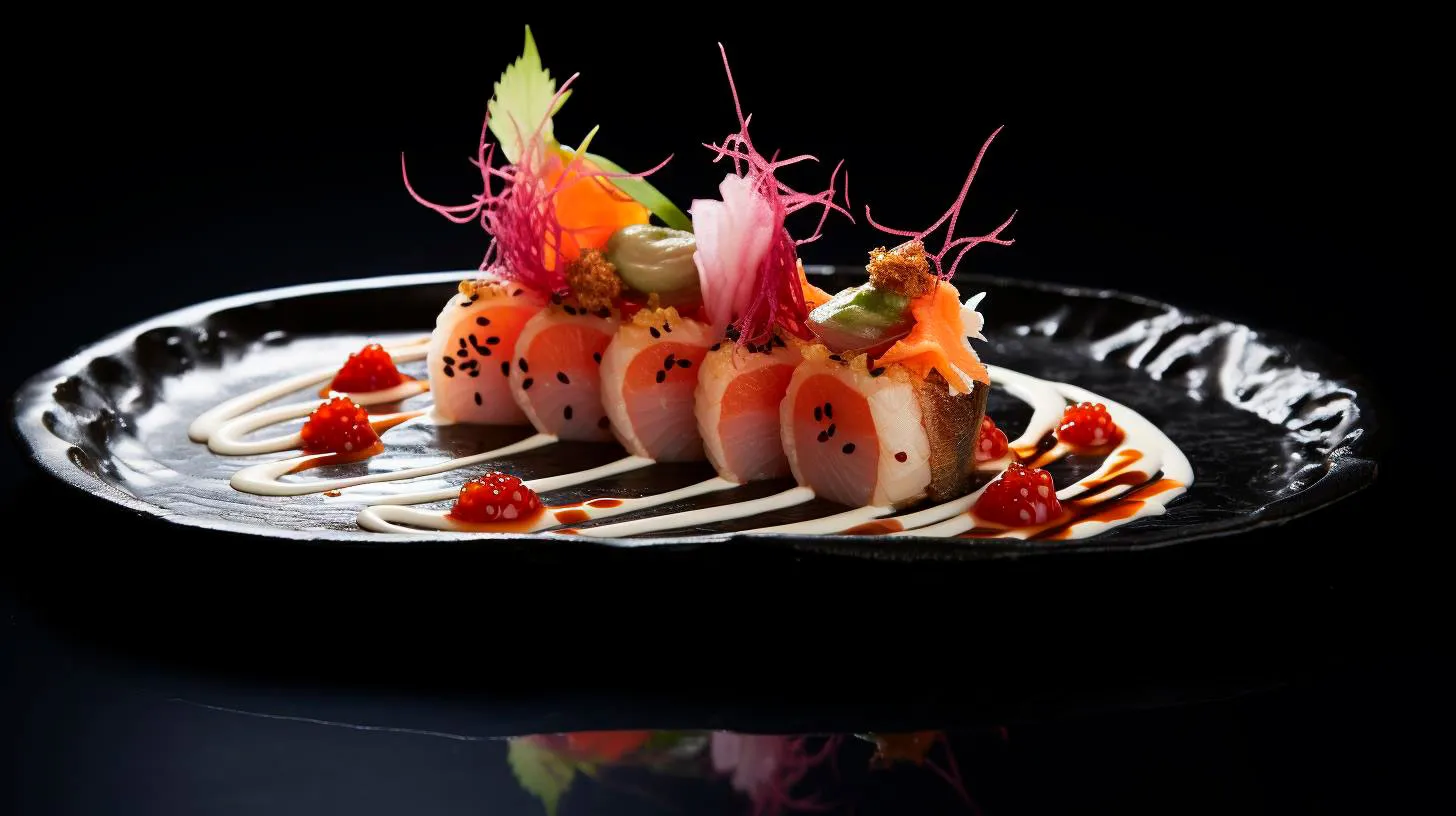From Roots to Rolls: Tracing the Journey of Authentic Wasabi
From the roots to the rolls, let’s trace the journey of authentic wasabi!
A Brief History
Before we dive into the roots of wasabi, let’s brush up on its history. Originating from the misty mountains of Japan, wasabi has been a beloved and staple ingredient of traditional Japanese cuisine for centuries. It was first cultivated in Japan during the 8th century AD, and since then, has captured the hearts and taste buds of gourmands worldwide.
Unearthing the Roots
Authentic wasabi, scientifically known as Wasabia japonica, is a member of the Brassicaceae family, much like its distant cousin, horseradish. However, this vibrant green condiment has a distinct flavor profile, aroma, and appearance that sets it apart.
Unlike the common misconception, wasabi is not a simple paste made from horseradish. In fact, the real deal comes from the rhizome, or root, of the wasabi plant. This root has a pale green color and an irresistible spiciness that delivers a delightful kick to any dish it accompanies.
The Art of Cultivating Wasabi
Cultivating authentic wasabi is a work of devotion and precision. Due to its specific requirements, growing wasabi outside of its natural habitat can be a daunting task. This remarkable plant demands a cool and shady environment, abundant freshwater, and precise soil conditions.
Today, most commercially available wasabi products are often substitutes made from horseradish, mustard, and food coloring, as cultivating true wasabi outside of Japan remains a challenge. However, dedicated farmers, driven by their passion for authenticity, have successfully started cultivating genuine wasabi in a few select regions around the world.
The Taste Sensation
The hallmark of authentic wasabi is its unique flavor profile. When finely grated, it releases a gentle heat that is distinguishable from the fiery punch of horseradish. This complexity of flavors, comprising an initial sweetness, followed by a hint of umami, and a gentle spiciness that dissipates quickly, adds depth to any dish it accompanies.
Key Takeaways:
- Authentic wasabi is derived from the rhizome of the wasabi plant, not horseradish.
- Wasabi requires specific growing conditions, making cultivation a challenge outside of Japan.
- Its flavor profile offers a unique blend of sweetness, umami, and a delightful spiciness.
Health Benefits
Apart from its delectable taste, authentic wasabi also boasts a range of health benefits. This green wonder is rich in antioxidants, vitamins, and minerals. It is known to have anti-inflammatory properties, aid digestion, and may even contribute to reducing the risk of certain cancers.
Studies have shown that the consumption of authentic wasabi can help lower blood pressure, support cardiovascular health, and provide relief from respiratory issues. Additionally, it may even possess antimicrobial properties, making it a valuable addition to your culinary repertoire.
Integrating Authentic Wasabi in Your Culinary Journey
Now that we have explored the intriguing world of authentic wasabi, it’s time to put our newfound knowledge to use. Here are a few ideas on how you can enrich your gastronomic ventures using this remarkable condiment:
- Pair freshly grated wasabi with sushi or sashimi for an unparalleled gustatory experience.
- Add a dab of wasabi to your deviled eggs or guacamole to elevate their flavor.
- Create a wasabi-infused mayonnaise to complement your sandwiches or seafood dishes.
- Experiment with incorporating wasabi in marinades or dressings to add a delightful zing.
By incorporating authentic wasabi into your culinary creations, you not only enhance the taste but also unlock the numerous health benefits it has to offer.
The Quest for Authenticity
As technology continues to advance, there is an increasing demand for authenticity and transparency in the culinary world. Food enthusiasts and gourmands alike are keen to explore unique flavors and traditional ingredients, such as authentic wasabi, that add an extra dimension to their dining experience.
Inspired by this quest for authenticity, farmers, researchers, and culinary experts are pushing the boundaries to cultivate genuine wasabi outside of Japan. This dedication ensures that the true essence of this remarkable condiment is savored by discerning palates across the globe.
Conclusion
From its humble roots to its prominent presence in culinary creations worldwide, authentic wasabi continues to captivate hearts and palates. Its rich history, unique cultivation requirements, and impeccable flavor profile make it a true gem among condiments.
So, the next time you savor that delectable piece of sushi or indulge in a plate of sashimi, remember the journey of authentic wasabi – a fusion of tradition, science, and the pursuit of flavor.
Mastering the Culinary Art Using Wasabi to Elevate Your Sushi Experience
Wasabi, also known as Japanese horseradish, is a spicy condiment that is often served alongside sushi. Derived from the Wasabia japonica plant, it is known for its pungent taste and vibrant green color. In addition to enhancing the flavor of sushi, wasabi also offers several health benefits.
The Perfect Pairing – Sushi and Wasabi
Sushi without wasabi is like a symphony without its conductor. They are the perfect duo that harmonizes the flavors of each individual ingredient. Here are some reasons why wasabi is an essential element in sushi:
- Flavor Enhancer: Wasabi adds a unique, pungent flavor profile to sushi. Its spicy kick complements the delicate flavors of the fish and the subtle sweetness of the rice, creating a perfect balance in every bite.
- Anti-Bacterial Properties: Studies have shown that wasabi possesses anti-bacterial properties that can help reduce the risk of foodborne illnesses. This natural defense mechanism of wasabi ensures the freshness and safety of your sushi.
- Digestive Aid: Wasabi has digestive properties that aid in breaking down the rich, fatty content found in sushi. It can help prevent any discomfort or bloating that may arise after indulging in this delectable cuisine.
Unlocking the Secrets of Wasabi
While wasabi is most commonly known in its paste form, it is actually the rhizome of the Wasabia japonica plant that is grated to create this spicy delight. To make the most of your culinary experience, it’s essential to understand the characteristics and quality of this unique condiment:
- Pungency and Heat: The taste and heat of wasabi vary depending on its freshness and the way it is prepared. Real wasabi has a mild heat that dissipates quickly, leaving a pleasant and refreshing flavor. When purchasing wasabi, look for products made from real wasabi rather than artificial substitutes.
- Color and Texture: Authentic wasabi has a vibrant green color, indicating its freshness. The texture should be smooth and creamy, allowing it to spread evenly on sushi. Avoid wasabi that appears dry or discolored as it may compromise the overall taste experience.
- Grating Technique: To ensure the best flavor, wasabi rhizome should be freshly grated just before consumption. Using a traditional tool called a wasabi grater or a fine grater, gently rub the rhizome in a circular motion to release the full potential of its flavor.
Using Wasabi Wisely
Mastering the art of using wasabi involves striking a delicate balance. Here are a few tips to make the most of your wasabi:
- Less is More: Wasabi is known for its strong flavor, so it’s best to use it sparingly. Start with a small amount and gradually add more if desired.
- Pairing with Soy Sauce: When dipping your sushi in soy sauce, it’s customary to add a touch of wasabi to create a harmonious blend of flavors. However, avoid mixing wasabi directly into the soy sauce, as this can overwhelm the delicate taste of sushi.
- Experiment with Condiments: Apart from traditional sushi, wasabi can also be used to elevate the flavors of other dishes. Try adding it to your salad dressings, mayonnaise, or even mashed potatoes for a unique twist.
The Final Spice
Wasabi is more than just a condiment – it is a culinary experience that elevates your sushi to new heights. Its delightful pungency, health benefits, and ability to enhance flavors make it an integral part of Japanese cuisine. So, the next time you savor a sushi roll, remember to indulge in the unique and invigorating flavors of wasabi.
The Science Behind Wasabi Unlocking Its Flavor Enhancing Powers
So, grab your chopsticks and prepare to be amazed!
What is Wasabi?
Before we dive into the science, let’s understand what Wasabi actually is. Wasabi is a green-colored condiment that originates from the root of the Wasabia japonica plant. Although it is often referred to as “Japanese horseradish,” Wasabi has a distinct flavor that sets it apart from its horseradish cousin.
Traditionally, Wasabi is served alongside sushi and sashimi to add an extra kick to the flavors. But what’s fascinating is that Wasabi doesn’t only contribute its unique taste to a dish; it also enhances the flavors of other ingredients. Let’s explore how.
The Compound that Unlocks the Magic
The secret lies in a compound called allyl isothiocyanate (AITC), which is found in Wasabi. AITC is responsible for the pungent and hot taste that Wasabi is famous for. But what makes it even more interesting is its ability to stimulate our taste buds and impact the overall flavor experience.
AITC works by activating TRPA1, a protein responsible for detecting pungent and irritating compounds in our taste buds. When AITC comes into contact with TRPA1, it triggers a response that enhances our perception of flavors, making them more vivid and intense. This is why Wasabi is often described as having a “clean” and “refreshing” taste.
Flavor Enhancing Powers
Now that we understand how Wasabi works at a molecular level, let’s explore its flavor enhancing powers and how they can elevate your culinary experience:
- Increased Sensitivity: Wasabi’s activation of TRPA1 receptors increases the sensitivity of our taste buds, allowing us to detect subtle flavors that might otherwise go unnoticed.
- Balancing Flavors: Wasabi has the incredible ability to balance the flavors of a dish. Its unique taste can cut through richness and add a refreshing contrast, enhancing the overall harmony of the flavors.
- Aromatics: The pungent aroma of Wasabi stimulates our olfactory system, amplifying the sensory experience. This makes each bite a delightful journey for both our taste buds and our sense of smell.
The Wasabi Paradox
Interestingly, the sensation of Wasabi’s heat is short-lived, lasting only a few seconds. This “Wasabi paradox” is due to an enzyme called myrosinase that breaks down AITC, causing its intensity to dissipate rapidly.
However, to truly appreciate the flavor enhancing powers of Wasabi, it is crucial to ensure you are consuming authentic Wasabi. Many commercially available Wasabi products actually contain very little or no real Wasabi, but rather consist of a mixture of horseradish, mustard, and food coloring. These imitation products lack the complex chemical composition that gives genuine Wasabi its unique taste and aroma.
The Takeaway
Wasabi’s flavor enhancing powers are not merely an old-wives’ tale; they have a scientific basis. The activation of TRPA1 receptors by AITC ignites a symphony of flavors, making your taste buds dance with joy. So, next time you have sushi or any dish that could use a burst of flavor, make sure you reach for authentic Wasabi and elevate your culinary experience to new heights!
We hope you enjoyed this deep dive into the science behind Wasabi. Join us next time as we explore another mouth-watering topic in the world of gastronomy. Until then, keep exploring flavors and expanding your culinary horizons!
Exploring Imitation Wasabi: How to Spot the Real Deal
But have you ever wondered if the wasabi you’re consuming is the real deal or just a cheap imitation? Join us as we unravel the secrets behind authentic wasabi and learn how to spot the genuine product.
The Imitation Game: Unveiling the Impostors
Imitation wasabi, often found in many restaurants and grocery stores, is a far cry from the real thing. Made primarily from horseradish, mustard, and food coloring, these impostors lack the complex flavor profile and health benefits of true wasabi. Here are a few characteristics to help you distinguish between real wasabi and its imitations:
- Ingredients: Authentic wasabi is made from the rhizome of the Wasabia japonica plant. Look for products that contain this natural ingredient to ensure you’re getting the real deal.
- Color: Real wasabi exhibits a vibrant, pale green color, while imitation wasabi tends to be a brighter, more artificial green hue.
- Texture: Genuine wasabi has a distinct, smooth, and paste-like texture compared to the coarse and granular texture of imitation products.
- Flavor: Traditional wasabi presents a subtly sweet and pungent taste that dissipates quickly, leaving a refreshing sensation. Imitations often possess a more aggressive, fiery taste that lingers on the palate.
The Real Deal: Benefits of Authentic Wasabi
Now that we’ve uncovered the counterfeits, let’s explore the advantages of consuming real wasabi:
- Anti-Microbial Properties: True wasabi has natural anti-microbial properties that can help combat harmful bacteria, making it a healthier option for your meals.
- Rich in Antioxidants: Authentic wasabi contains compounds like isothiocyanates, which have antioxidant properties, leading to potential health benefits.
- Anti-Inflammatory: Real wasabi possesses anti-inflammatory properties that may help reduce inflammation in the body, benefiting overall health.
- Improved Digestion: Consuming authentic wasabi may aid digestion by stimulating the production of digestive enzymes.
Spotting Real Wasabi in the Wild
When dining out or shopping for wasabi products, keep these tips in mind to help identify the genuine product:
- Inspect the label carefully to ensure it contains Wasabia japonica as the primary ingredient.
- Avoid wasabi powders or pastes with an unnaturally bright green color.
- Look for reputable brands known for their commitment to quality and authenticity.
- If in doubt, ask the staff or consult with a trusted local chef who can guide you towards the real deal.
In Summary
Don’t fall prey to imitation wasabi! Arm yourself with these tips and seek out the authentic product for that perfect sushi experience. Real wasabi offers unique flavors and potential health benefits, making it a culinary gem worth exploring.
Remember, when it comes to wasabi, always look beyond the disguise and uncover the genuine article. Your taste buds and the quality of your meals will thank you.



